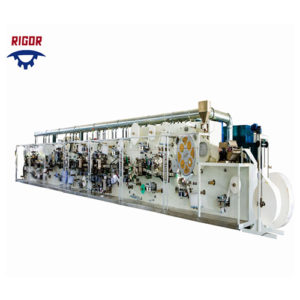Sanitary napkin machinery plays a crucial role in supporting sustainable manufacturing practices in several ways:
- Efficient Resource Utilization: Modern sanitary napkin machinery is designed to optimize the use of raw materials, such as absorbent cores and outer layers, reducing waste and minimizing material consumption. This efficient resource utilization helps conserve natural resources and reduce the environmental impact of manufacturing.
- Energy Efficiency: Sanitary napkin machinery incorporates energy-efficient technologies, such as servo motors, variable frequency drives, and automated controls, to minimize energy consumption during the manufacturing process. By reducing energy usage, machinery supports sustainable practices and lowers the carbon footprint of production facilities.
- Water Conservation: Some sanitary napkin machinery is equipped with water-saving features, such as closed-loop water systems and efficient cooling mechanisms, to minimize water usage in the manufacturing process. These water conservation measures help conserve water resources and reduce wastewater discharge.
- Waste Reduction: Advanced sanitary napkin machinery is designed to minimize production waste through precise cutting, shaping, and packaging processes. By reducing waste generation, machinery supports sustainable practices and minimizes the environmental impact of manufacturing operations.
- Recyclability and Biodegradability: Sanitary napkin machinery enables the production of products that are recyclable or biodegradable, supporting circular economy principles and reducing the environmental burden of disposable hygiene products. Machinery can incorporate sustainable materials and processes to enhance product recyclability and biodegradability.
- Emissions Reduction: By incorporating pollution control technologies and adhering to emission regulations, sanitary napkin machinery helps reduce air and water pollutants emitted during the manufacturing process. This emissions reduction contributes to cleaner air and water quality, supporting environmental sustainability.
- Product Lifecycle Considerations: Sanitary napkin machinery manufacturers may consider the entire lifecycle of the products they produce, from raw material sourcing to end-of-life disposal. By optimizing product design, materials selection, and manufacturing processes, machinery can support sustainable product lifecycles and minimize environmental impacts.
- Compliance with Sustainability Standards: Sanitary napkin machinery manufacturers may develop machinery that complies with sustainability standards and certifications, such as ISO 14001 (Environmental Management Systems) and LEED (Leadership in Energy and Environmental Design). Compliance with these standards demonstrates a commitment to sustainable manufacturing practices and environmental responsibility.
Overall, sanitary napkins machinery supports sustainable manufacturing practices by promoting resource efficiency, energy conservation, waste reduction, emissions reduction, and the production of environmentally friendly products. By incorporating sustainable principles into design, operation, and maintenance, machinery plays a vital role in advancing environmental sustainability in the hygiene product manufacturing industry.
What are the cost-saving benefits of investing in sanitary napkin machinery?
Investing in sanitary napkin machinery can yield several cost-saving benefits for manufacturers. Here are some of the key advantages:
- Reduced Labor Costs: Sanitary napkin machinery automates many production processes, reducing the need for manual labor. This results in significant savings on labor costs, as fewer workers are required to operate and monitor the manufacturing line.
- Higher Production Efficiency: Modern sanitary napkin machinery is designed for high-speed and continuous production, leading to increased output and higher efficiency compared to manual methods. This higher production efficiency allows manufacturers to produce more products in less time, maximizing throughput and reducing unit costs.
- Optimized Material Usage: Sanitary napkin machinery is equipped with precision cutting and shaping mechanisms that minimize material waste. By optimizing material usage and reducing scrap, manufacturers can lower material costs and improve overall profitability.
- Lower Overhead Expenses: Investing in China sanitary napkin machinery eliminates the need to outsource production to third-party manufacturers, reducing overhead expenses associated with outsourcing, such as transportation, storage, and administrative costs. Manufacturers can streamline operations and control production costs more effectively by bringing manufacturing in-house.
- Long-term Cost Stability: Once installed, sanitary napkin machinery provides a stable and predictable production environment, allowing manufacturers to forecast and budget production costs more accurately. Unlike outsourcing or manual production methods, machinery offers long-term cost stability and predictability, minimizing the risk of cost fluctuations.
- Minimized Downtime and Maintenance Costs: Modern sanitary napkin machinery is designed for reliability and uptime, with built-in diagnostics and preventive maintenance features that minimize downtime and reduce maintenance costs. Manufacturers can avoid costly production interruptions and emergency repairs by investing in reliable machinery.
- Enhanced Product Quality and Consistency: Sanitary napkin machinery ensures consistent product quality and uniformity, reducing the likelihood of defects, rework, and product recalls. By producing high-quality products consistently, manufacturers can minimize costs associated with quality control, customer complaints, and product returns.
- Flexibility and Adaptability: Many sanitary napkin machinery systems offer flexibility and adaptability, allowing manufacturers to quickly adjust production parameters and switch between product variations. This flexibility enables manufacturers to respond to changing market demands and customer preferences without incurring additional costs.
- Competitive Advantage: Investing in sanitary napkin machinery can provide manufacturers with a competitive advantage in the market by improving production efficiency, reducing costs, and enhancing product quality. Manufacturers can offer competitive pricing while maintaining profitability, positioning themselves as industry leaders and attracting more customers.
Overall, investing in sanitary napkin machinery offers numerous cost-saving benefits for manufacturers, including reduced labor costs, higher production efficiency, optimized material usage, lower overhead expenses, long-term cost stability, minimized downtime, enhanced product quality, flexibility, and a competitive advantage in the market. These cost-saving benefits contribute to improved profitability and business success for sanitary napkin manufacturers.
